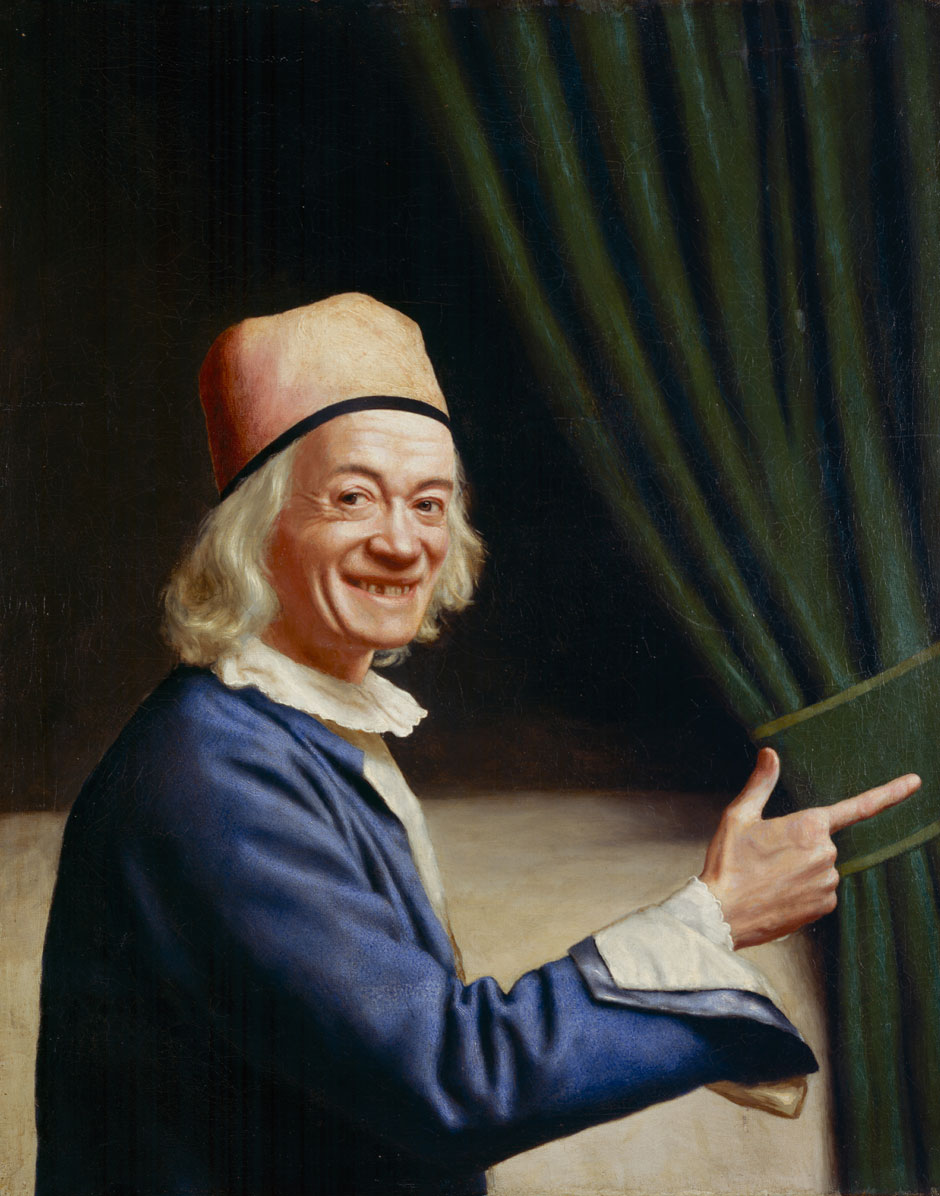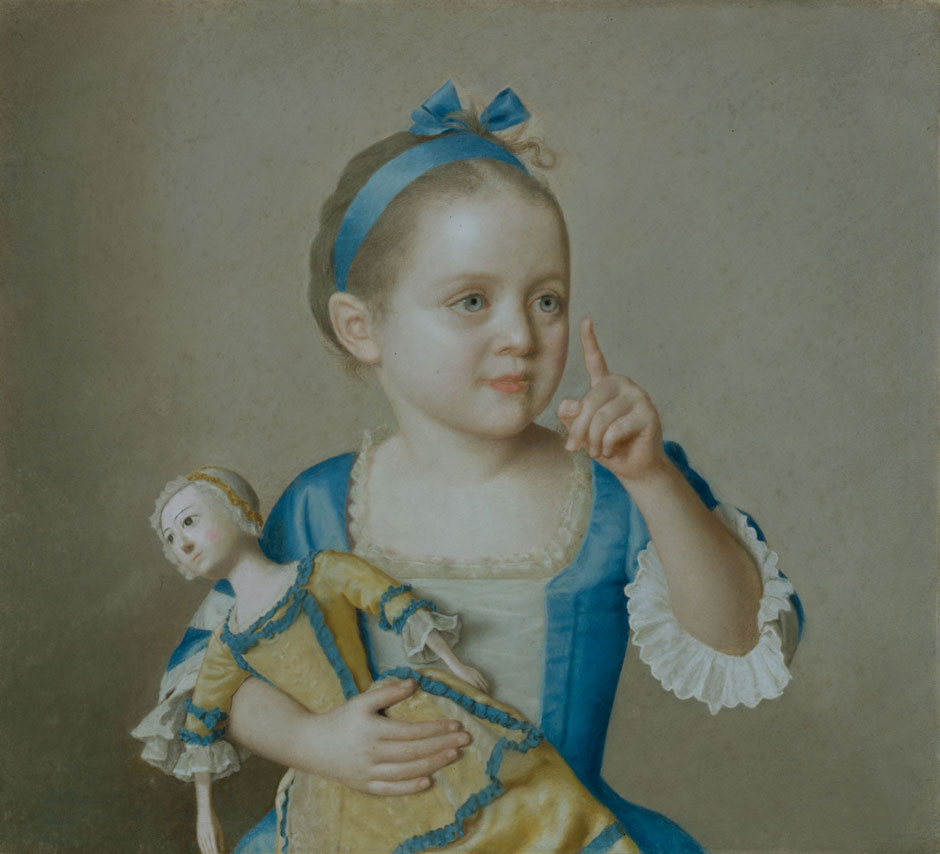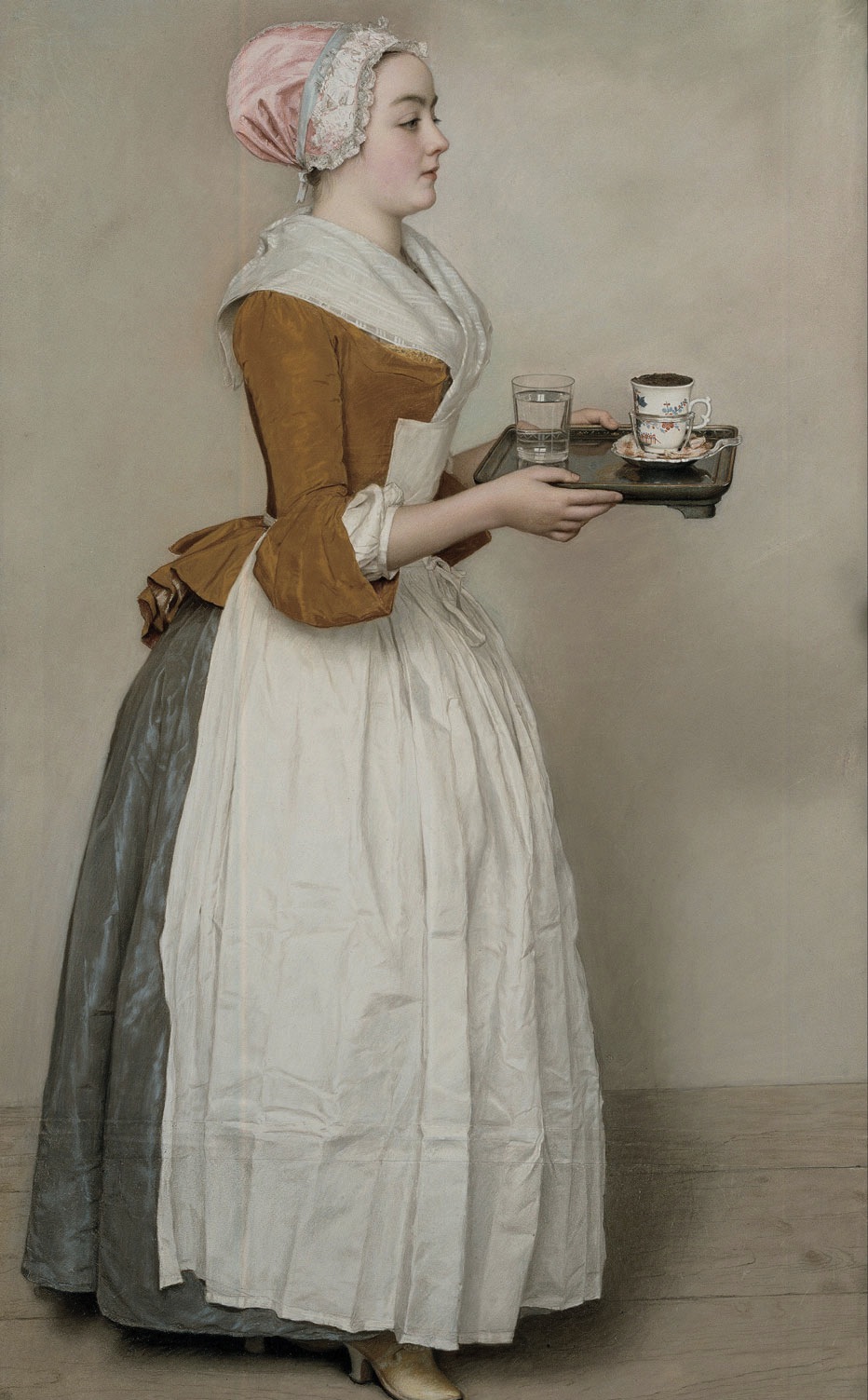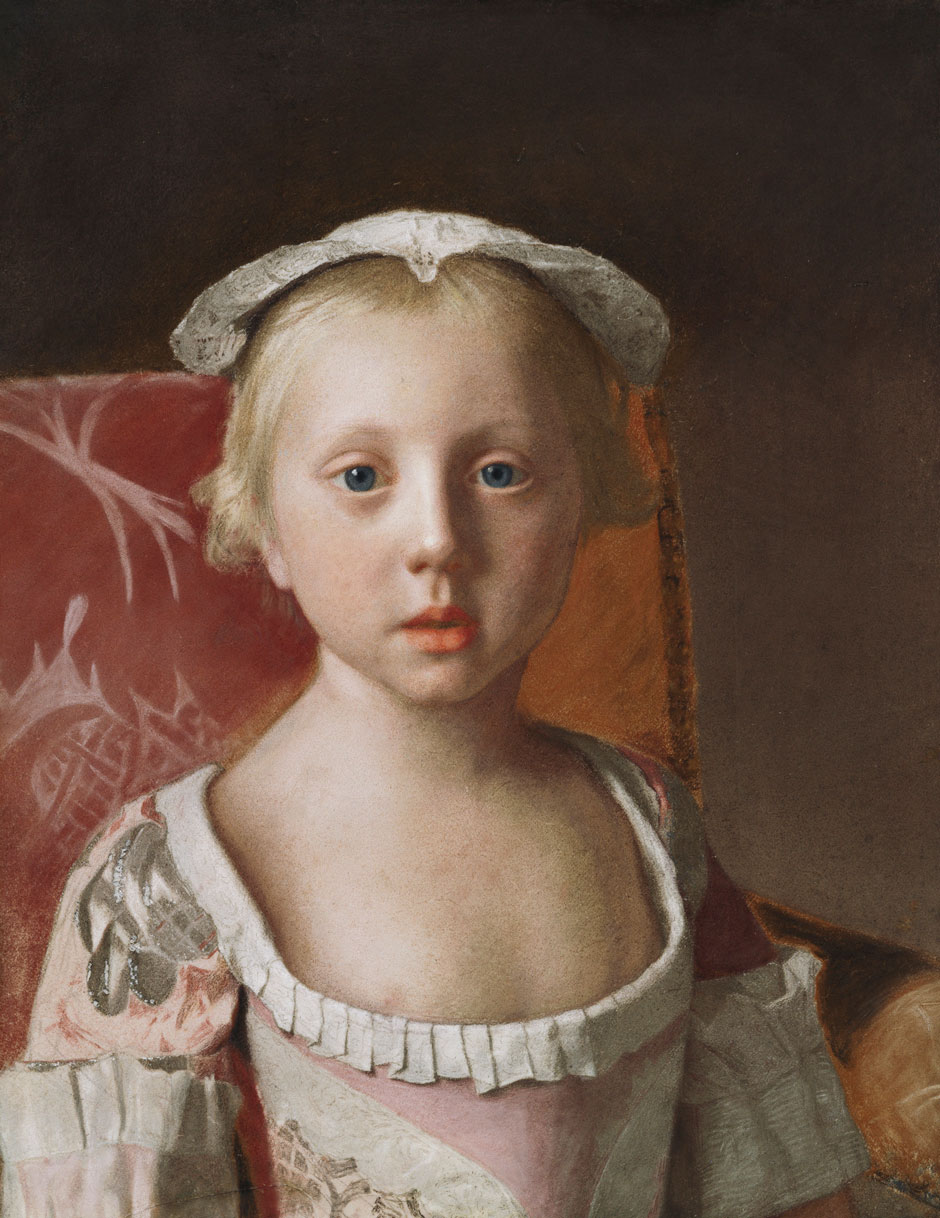It’s odd when, after seeing an exhibition of portraits, the ones that stay in my mind aren’t of the great and good and glamorous, but of minor figures, slipped in among the throng—servants, or needlewomen, or children. This is certainly the case with the remarkable show of Jean-Étienne Liotard (1702-1789) at Edinburgh. It’s two weeks now since I saw it, yet I’m still puzzling over the nature of the Swiss-French painter’s charm and strength.
I find that the images that linger are not those of his most famous clients, the royal families of Britain, France, and Austria, but scenes like La Chocolatiere (1744-1745), the maid in her starched apron, still showing the creases where it was folded, carrying the cup with such care, or the red and black chalk study of the woman kneeling to embroider on her wooden frame, from his time in Constantinople, or the pastel of his own small daughter, Marianne. Holding a limp-armed, smartly dressed doll in the crook of her elbow, she holds up a warning finger as if to say—“Shh, she’s asleep.” Like her doll, she is dressed in her best, her chubby arm framed in a ruff of white lace, her hair tied back with a blue satin bow. Her gaze is solemn, with the hint of a smile as she poses for her father.
This was doubtless a display piece to woo clients. And the atmosphere of the Edinburgh show amplified its seductive appeal. It almost flaunted its modesty in comparison to the Scottish National Gallery’s other exhibition coinciding with this year’s Edinburgh International Festival, David Bailey’s Stardust, five decades of photographs of the rich and famous interspersed with trips abroad. And such a contrast too, to the streets outside. At Festival time Edinburgh seethes with crowds of all nationalities, surging up the Royal Mile, dashing across Princes Street. Posters for Fringe shows plaster the railings. Street cafes overflow. Buskers belt out their songs on the corners. On the day I encountered Liotard the air was crisp and clear, with the flags on the castle streaming in a westerly wind. Entering the dim-lit rooms of the Liotard show was like going into a shell, a curving, murmuring, undersea space, where portraits shone and seemed to speak.
This particular “shine” is a quality of pastels—their ground pigments bound by gum into dusty chalk crayons. Works in pastel were at the height of their popularity in the mid-eighteenth century, when their soft sheen suited candle-lit rooms and intimate interiors. The polite world of London and Paris was entranced by the work of Rosalba Carriera in the 1720s, and even more by the skill of Liotard’s contemporary, Maurice Quentin de Latour. Liotard too was a master of his art, but he offered something slightly different: flat, brilliant colors, a hypnotic attention to details of face, clothes, jewels. With these went a refusal to flatter, defying the ethos of neoclassical idealism, often uncomfortably so. Stray locks of hair, double-chins, boastful smiles, reluctant frowns, coquettish twinkles, all are noticed, all are alive. His likenesses, noted Horace Walpole, “were as exact as possible, and too like… Freckles, marks of the small-pox, every thing found its place… Truth prevailed in his works, grace in very few.” This honesty—he refused to paint a woman with too much make-up—makes some of his work feel curiously modern. His portrait of Charlotte Boyle, Marchioness of Hartington (1754), for example, could come from the 1930s. Her plain, good-natured face gazes out quizzically, her neck encircled by a fur-lined, blue satin cloak, her cheeks reddened by the small-pox that would kill her the same year.
But Liotard did not disdain romance, or flashiness. His own life was worthy of a surprise star at this International Festival. Born in Geneva, to French Huguenot emigrés, he trained first as a miniaturist and worked in Paris, London, Amsterdam, Venice, Naples, and Rome. In Constantinople in the late 1730s and early 1740s he made evocative chalk studies of local subjects, painted sensuous, lazy Ottoman interiors, and turned out grand portraits of British dignitaries, like his patron William Ponsonby, Viscount Duncannon, and his wife Caroline, both in sumptuous Oriental dress.
Arriving in London in 1753 sporting a long curly beard, fur hat, and kaftan modelled on the robes at the court of Moldavia (modern Romania), Liotard “the Turk” was an immediate success in society. His exotic touch, a perfect fit with the vogue at the time for Orientalism, outraged fellow professionals: Joshua Reynolds cursed him as a “Quack” and “the very essence of imposture.” Liotard stuck to his imposture. As his beard grew longer and longer, he celebrated it in a series of extraordinary self-portraits. And though he shaved off his beard when he married the young Marie Fargues, he still kept up the performance. His self-portrait laughing, with gap-toothed grin and pointing finger—but pointing where?—still makes one jump, and smile.
Advertisement
In Paris, before his British stay, he had showed his skill at conveying character in his portraits of David Garrick (a quicksilver actor, so often painted, but so hard to capture) and his calm and easy-natured wife Eva-Maria. These paved the way for smart introductions, including one to Augusta, Princess of Wales. Liotard’s pastel showed her sturdily open, free of swank, and he went on to make equally frank portraits of her nine children, from the sixteen-year-old George, affable in his garter robes, to the six year-old Louisa Anne. Surely this is the most poignant of royal portraits—a frail child with pale lashes and nervous, open-eyed gaze, made even more fragile by the huge chair and too-big dress which uncovers a pale nipple, a touchingly un-royal detail.
These intimate, candid images were private portraits, carried about like family photographs. They stop being “personages” and become people, like the servant or the artist’s own daughter. And perhaps the portraits’ eerie power comes partly from our own hindsight—we know the subjects’ fate while they remain innocently unaware. Louisa-Anne, for example, would die of tuberculosis at the age of nineteen. And on his second long visit to Vienna in 1762, when Liotard made drawings of eleven of the twelve children of the Empress Maria Theresa, he caught another doomed princess, the seven-year-old Marie Antoinette. Here she sits, with her fashionable curled hair and a rose-colored dress smothered in bows, poised and assured, casting a sidelong glance as she unwinds a thread for sewing.
The Fates had other threads to weave. Liotard himself died at the age of eighty-seven in 1789, a month before the storming of the Bastille and the start of the French Revolution: in many ways his long career tracks the final years of the ancien régime in Europe, with its love of luxury and display. Yet for all his showmanship, Liotard’s greatest art, as Walpole said, was in catching a likeness; and in grasping the fleeting moment, he casts us too back in time.
“Jean-Étienne Liotard” is on view at the National Gallery of Scotland through September 13 and at the Royal Academy, London, from October 24 through January 31, 2016 .





